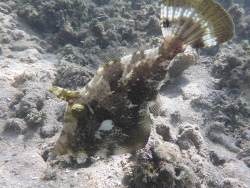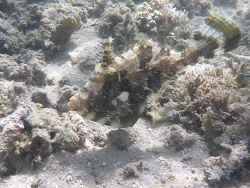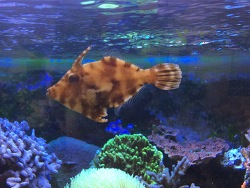Info
Acreichthys tomentosus, Linnaeus, 1758
The seagrass or also kelp filefish (Acreichthys tomentosus) lives in the tropical Indo-Pacific.
They live mainly in seagrass beds and among algae stands near coral reefs and protected lagoons. Normally they are solitary. However, their willingness to eat small sea anemones such as Manyano sea anemones also varies individually. The fish may also eat tubeworms and large polyp stony corals or certain soft corals. Depending....
Sex Recognition:
Males are relatively easy to identify by a row of bristles located just in front of the caudal fin.
Danger of confusion
Monacanthus ciliatus
This following information comes from Michael Megerle:
It took a week for the fish to settle in and behave normally. Then it immediately accepted Artemia and also started to inspect the tank with interest. The seaweed filefish seems to be an omnivore with a preference for sea anemones.
In my tank, after 4 weeks of keeping it so far, it has arranged its menu (in this order) as follows: 14 days after the fish was introduced, the issue of glass lice and majanos was settled.
First he ate the glass lice (also the very big ones) and then the majanos.
However, the infestations kept within limits - I didn't have any majano or glass lice carpets in the tank before the fish was introduced ;-).
But even for that he would have needed only a little longer...
Once Acreichthys tomentosus has set his sights on something, he stays on it tirelessly!
After the issue of mini anemones was settled, he went after two different species of Xenia's (after a few days break) with the same zeal!
These too were no longer an issue after a few days....
After that he went after a large polyped stony coral, which I therefore had to remove from the tank.
What he also eats sporadically are crustose anemones and tree soft corals - but so far not specifically and not with the same persistence as the aforementioned things.
From time to time he bites - apparently only to try - into a SPS coral, but without damaging it permanently.
I have also observed him trying to "eat" an Astrea snail from the side.
However, this has gone fast into cover. Equally interested, he has also eyed my little Sexy Shrimps.
But they made a hop into a Hystrix, when it became too "queasy" for them.
My Tridacna mussels, all kinds of tubeworms and everything else that crawls and flies, he has not touched so far. (Although Prof. Ellen Thaler writes that he has a preference for tubeworms).
Also a "meadow" with Anthelia, which I would like to get rid of, he punishes with contempt ;-).
The seagrass filefish is certainly the right choice if the main focus of a tank is on SPS stony corals.
Large polyp stony corals must certainly be avoided, although I keep several Fungia and a Cynarina, which he does not pay attention to at all so far.
Even if you keep a mixed stock of soft corals and sea anemones in your tank, the seagrass filefish is certainly not the ideal contemporary due to its diet, as it will probably "flatten" quite a bit in it in the long run ;-).
However, the fish has a very interesting behavior and is - both in appearance and behavior - a nice contrast to the other fish in the tank.
It is able to adapt its colors and patterns to the environment in a flash.
Addendum: A few days ago the Feili showed his true face ;-).
Although well and varied fed (krill, artemia, mussels, green food), he started to eat massively at the stony corals.
And also on all small polyps (Acro, Stylo, Monti).
I therefore removed the filefish from the stony coral tank and transferred it to a species tank.
The catching out was done in 10 seconds.
You could almost lift it out of the tank with your hand.
In this respect it was an easier task than, for example, with a butterflyfish.
So it is definitely not only that the filefish selectively bites sea anemones, soft corals and large polyped stonis.
Rather, observation has shown that, depending on the individual and its mood, it will unspecifically go after anything that gets in its way (either sooner or later).
This following info comes from Michael Megerle:
It took a week for the fish to settle in and behave normally.Then he immediately accepted Artemia and also began to inspect the tank with interest. The seaweed filefish seems to be an omnivore with a preference for sea anemones.
In my tank, after 4 weeks of keeping it so far, its "menu" (in this order) was as follows: 14 days after the fish was introduced, the issue of glass lice and majanos was settled.
Zuerst hat er die Glasrosen gefressen (auch die ganz großen) und dann die Majanos.
However, the infestations kept within limits - I didn't have any majano or glass lice carpets in the tank before the fish was introduced ;-).But even for that he would have needed only a little longer...
Once Acreichthys tomentosus has set his sights on something, he stays on it tirelessly!
After the issue of mini anemones was settled, he went after two different species of Xenia's (after a few days break) with the same zeal!
These too were no longer an issue after a few days....After that he went after a large polyped stony coral, which I therefore had to remove from the tank.
What he also eats sporadically are crustose anemones and tree soft corals - but so far not specifically and not with the same persistence as the aforementioned things.
From time to time he bites - apparently only to try - into a SPS coral, but without damaging it permanently.
I have also observed him trying to "eat" an Astrea snail from the side.However, this has gone fast into cover. Equally interested, he has also eyed my little Sexy Shrimps.
But they made a hop into a Hystrix, when it became too "queasy" for them.
My Tridacna mussels, all kinds of tubeworms and everything else that crawls and flies, he has not touched so far. (Although Prof. Ellen Thaler writes that he has a preference for tubeworms).
Also a "meadow" with Anthelia, which I would like to get rid of, he punishes with contempt ;-).
The seagrass filefish is certainly the right choice if the main focus of a tank is on SPS stony corals.
Large polyp stony corals must certainly be avoided, although I keep several Fungia and a Cynarina, which he does not pay attention to at all so far.
Even if you keep a mixed stock of soft corals and sea anemones in your tank, the seagrass filefish is certainly not the ideal contemporary due to its diet, as it will probably "flatten" quite a bit in it in the long run ;-).
However, the fish has a very interesting behavior and is - both in appearance and behavior - a nice contrast to the other fish in the tank.
It is able to adapt its colors and patterns to the environment in a flash.
Addendum: A few days ago the Feili showed his true face ;-).
Although well and varied fed (krill, artemia, mussels, green food), he started to eat massively at the stony corals.
And also on all small polyps (Acro, Stylo, Monti).
I therefore removed the filefish from the stony coral tank and transferred it to a species tank.
The catching out was done in 10 seconds.
You could almost lift it out of the tank with your hand.
In this respect it was an easier task than, for example, with a butterflyfish.
So it is definitely not only that the filefish selectively bites sea anemones, soft corals and large polyped stonis.
Rather, observation has shown that, depending on the individual and its mood, it will unspecifically go after anything that gets in its way (either sooner or later).
It is not even sure if he eats the tissue of the Steinis or if he just bites at it to have something to do.
Because normally he always spits out the tissue after he has bitten it off.
In conclusion, the seagrass filefish is a sure bet for glass hawser and majano control!
However, in a coral reef tank with an emphasis on stony corals, it can usually only be a temporary guest.
For this reason, you should talk to the dealer about a return already at the time of purchase (not at full price, of course, but perhaps at half price).
Alternatively you have to have a special aquarium, into which you can move the animal if necessary.
Also, it must be remembered that the pests may slowly reappear after some time when this predator is no longer there.
In that case you will have to use the services of the seaweed tetra once again ;-).
Burgess gives the size with 10 cm.
However, this is not true - as a rule, they will probably reach about 15 - 20 cm in the aquarium.
In nature they are more likely to reach 30 cm.
SUPPLEMENT: The behavior described by Michael Megerle with regard to glass lizards and majanos has been confirmed several times.However, there are also contrary reports, in which the filefish partout did not want to go to these sea anemones.
It seems that there might be individual preferences regarding the food...
In 2008 this filefish was already successfully bred.
Synonyms:
Balistes tomentosus Linnaeus, 1758
Monacanthus tomentosus (Linnaeus, 1758)
Parvagor tomentosus (Linnaeus, 1758) (misspelling)
Pervagor tomentosus (Linnaeus, 1758)
Stephanolepis tomentosus (Linnaeus, 1758)
The seagrass or also kelp filefish (Acreichthys tomentosus) lives in the tropical Indo-Pacific.
They live mainly in seagrass beds and among algae stands near coral reefs and protected lagoons. Normally they are solitary. However, their willingness to eat small sea anemones such as Manyano sea anemones also varies individually. The fish may also eat tubeworms and large polyp stony corals or certain soft corals. Depending....
Sex Recognition:
Males are relatively easy to identify by a row of bristles located just in front of the caudal fin.
Danger of confusion
Monacanthus ciliatus
This following information comes from Michael Megerle:
It took a week for the fish to settle in and behave normally. Then it immediately accepted Artemia and also started to inspect the tank with interest. The seaweed filefish seems to be an omnivore with a preference for sea anemones.
In my tank, after 4 weeks of keeping it so far, it has arranged its menu (in this order) as follows: 14 days after the fish was introduced, the issue of glass lice and majanos was settled.
First he ate the glass lice (also the very big ones) and then the majanos.
However, the infestations kept within limits - I didn't have any majano or glass lice carpets in the tank before the fish was introduced ;-).
But even for that he would have needed only a little longer...
Once Acreichthys tomentosus has set his sights on something, he stays on it tirelessly!
After the issue of mini anemones was settled, he went after two different species of Xenia's (after a few days break) with the same zeal!
These too were no longer an issue after a few days....
After that he went after a large polyped stony coral, which I therefore had to remove from the tank.
What he also eats sporadically are crustose anemones and tree soft corals - but so far not specifically and not with the same persistence as the aforementioned things.
From time to time he bites - apparently only to try - into a SPS coral, but without damaging it permanently.
I have also observed him trying to "eat" an Astrea snail from the side.
However, this has gone fast into cover. Equally interested, he has also eyed my little Sexy Shrimps.
But they made a hop into a Hystrix, when it became too "queasy" for them.
My Tridacna mussels, all kinds of tubeworms and everything else that crawls and flies, he has not touched so far. (Although Prof. Ellen Thaler writes that he has a preference for tubeworms).
Also a "meadow" with Anthelia, which I would like to get rid of, he punishes with contempt ;-).
The seagrass filefish is certainly the right choice if the main focus of a tank is on SPS stony corals.
Large polyp stony corals must certainly be avoided, although I keep several Fungia and a Cynarina, which he does not pay attention to at all so far.
Even if you keep a mixed stock of soft corals and sea anemones in your tank, the seagrass filefish is certainly not the ideal contemporary due to its diet, as it will probably "flatten" quite a bit in it in the long run ;-).
However, the fish has a very interesting behavior and is - both in appearance and behavior - a nice contrast to the other fish in the tank.
It is able to adapt its colors and patterns to the environment in a flash.
Addendum: A few days ago the Feili showed his true face ;-).
Although well and varied fed (krill, artemia, mussels, green food), he started to eat massively at the stony corals.
And also on all small polyps (Acro, Stylo, Monti).
I therefore removed the filefish from the stony coral tank and transferred it to a species tank.
The catching out was done in 10 seconds.
You could almost lift it out of the tank with your hand.
In this respect it was an easier task than, for example, with a butterflyfish.
So it is definitely not only that the filefish selectively bites sea anemones, soft corals and large polyped stonis.
Rather, observation has shown that, depending on the individual and its mood, it will unspecifically go after anything that gets in its way (either sooner or later).
This following info comes from Michael Megerle:
It took a week for the fish to settle in and behave normally.Then he immediately accepted Artemia and also began to inspect the tank with interest. The seaweed filefish seems to be an omnivore with a preference for sea anemones.
In my tank, after 4 weeks of keeping it so far, its "menu" (in this order) was as follows: 14 days after the fish was introduced, the issue of glass lice and majanos was settled.
Zuerst hat er die Glasrosen gefressen (auch die ganz großen) und dann die Majanos.
However, the infestations kept within limits - I didn't have any majano or glass lice carpets in the tank before the fish was introduced ;-).But even for that he would have needed only a little longer...
Once Acreichthys tomentosus has set his sights on something, he stays on it tirelessly!
After the issue of mini anemones was settled, he went after two different species of Xenia's (after a few days break) with the same zeal!
These too were no longer an issue after a few days....After that he went after a large polyped stony coral, which I therefore had to remove from the tank.
What he also eats sporadically are crustose anemones and tree soft corals - but so far not specifically and not with the same persistence as the aforementioned things.
From time to time he bites - apparently only to try - into a SPS coral, but without damaging it permanently.
I have also observed him trying to "eat" an Astrea snail from the side.However, this has gone fast into cover. Equally interested, he has also eyed my little Sexy Shrimps.
But they made a hop into a Hystrix, when it became too "queasy" for them.
My Tridacna mussels, all kinds of tubeworms and everything else that crawls and flies, he has not touched so far. (Although Prof. Ellen Thaler writes that he has a preference for tubeworms).
Also a "meadow" with Anthelia, which I would like to get rid of, he punishes with contempt ;-).
The seagrass filefish is certainly the right choice if the main focus of a tank is on SPS stony corals.
Large polyp stony corals must certainly be avoided, although I keep several Fungia and a Cynarina, which he does not pay attention to at all so far.
Even if you keep a mixed stock of soft corals and sea anemones in your tank, the seagrass filefish is certainly not the ideal contemporary due to its diet, as it will probably "flatten" quite a bit in it in the long run ;-).
However, the fish has a very interesting behavior and is - both in appearance and behavior - a nice contrast to the other fish in the tank.
It is able to adapt its colors and patterns to the environment in a flash.
Addendum: A few days ago the Feili showed his true face ;-).
Although well and varied fed (krill, artemia, mussels, green food), he started to eat massively at the stony corals.
And also on all small polyps (Acro, Stylo, Monti).
I therefore removed the filefish from the stony coral tank and transferred it to a species tank.
The catching out was done in 10 seconds.
You could almost lift it out of the tank with your hand.
In this respect it was an easier task than, for example, with a butterflyfish.
So it is definitely not only that the filefish selectively bites sea anemones, soft corals and large polyped stonis.
Rather, observation has shown that, depending on the individual and its mood, it will unspecifically go after anything that gets in its way (either sooner or later).
It is not even sure if he eats the tissue of the Steinis or if he just bites at it to have something to do.
Because normally he always spits out the tissue after he has bitten it off.
In conclusion, the seagrass filefish is a sure bet for glass hawser and majano control!
However, in a coral reef tank with an emphasis on stony corals, it can usually only be a temporary guest.
For this reason, you should talk to the dealer about a return already at the time of purchase (not at full price, of course, but perhaps at half price).
Alternatively you have to have a special aquarium, into which you can move the animal if necessary.
Also, it must be remembered that the pests may slowly reappear after some time when this predator is no longer there.
In that case you will have to use the services of the seaweed tetra once again ;-).
Burgess gives the size with 10 cm.
However, this is not true - as a rule, they will probably reach about 15 - 20 cm in the aquarium.
In nature they are more likely to reach 30 cm.
SUPPLEMENT: The behavior described by Michael Megerle with regard to glass lizards and majanos has been confirmed several times.However, there are also contrary reports, in which the filefish partout did not want to go to these sea anemones.
It seems that there might be individual preferences regarding the food...
In 2008 this filefish was already successfully bred.
Synonyms:
Balistes tomentosus Linnaeus, 1758
Monacanthus tomentosus (Linnaeus, 1758)
Parvagor tomentosus (Linnaeus, 1758) (misspelling)
Pervagor tomentosus (Linnaeus, 1758)
Stephanolepis tomentosus (Linnaeus, 1758)







 timibo
timibo





























